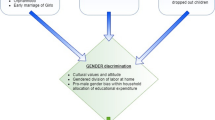Abstract
The Union Budget 2018–19 proposed an overarching programme—Samagra Shiksha Abhiyan (SMSA) envisaging to treat school education holistically from pre-nursery to class 12, with a broader goal of improving school effectiveness and ensuring equitable opportunities and learning outcomes. The gender budget statement introduced by the Government of India let SMSA lay special focus on Girls’ Education through upgradation of erstwhile functioning Kasturba Gandhi Balika Vidyalayas (KGBVs) from class 6–8 to class 6–12. This paper analyses how the school education budget is designed in KGBVs to ensure enrolment and retention of adolescent girls predominantly belonging to Scheduled Castes, Scheduled Tribes and Other Backward Classes, students residing Below Poverty Line, and with special needs. It also highlights the factors that influence the delay in receipt and optimum utilization of funds at the school level. The study was conducted in four districts of Rajasthan—Jaipur, Udaipur, Jaisalmer and Bharatpur. Multi-stage sampling technique was used to include a total of 18 KGBVs in the selected state. It was found that teachers and wardens are the core of a KGBV, and their role in quality improvement is paramount. Thus, regular training of teachers and wardens is imperative to ensure the quality of education and resource management at school level. Infrastructural quality as well as optimum utilization are other factors that play a key role in ensuring enrolment and retention of adolescent girls in KGBVs.
Access this chapter
Tax calculation will be finalised at checkout
Purchases are for personal use only
Similar content being viewed by others
References
CBGA and UNICEF. 2011. Sarva Siksha Abhiyan. In Budgeting for Change. New Delhi.
Chakraborty, L. 2016. Asia: A Survey of Gender Budgeting Efforts. IMF Working Papers 16 (150): 1. https://doi.org/10.5089/9781475519914.001.
Chauhan, D. 2017. Gender Responsive Budgeting: Training of Trainers’ Manual for Civil Society Organizations. National Foundation for India. Retrieved from http://www.nfi.org.in/sites/default/files/publication/NFI-GRB-TM_LowRes.pdf.
Government of Rajasthan. 2006. Gender Responsive Budgeting for the Department of Education, vol. 2. Retrieved from https://www.yumpu.com/en/document/read/32335203/gender-responsive-budgeting-for-the-department-of-education.
Kowtal, A., and B. Nafees. 2014. Towards Inclusive Budgeting for Dalit Women. All India Dalit Mahila Adhikar Manch. Retrieved from http://www.feministpolicyindia.org/documents/resources/inclusive-budgeting-for-Dalit-women.pdf.
Kundu, P. 2013. Budget for Education. Yojana.
Kundu, P., and D. Rastogi. 2020. Budgetary Analysis of Samagra Shiksha Abhiyan. Centre for Budget and Governance Accountability & CRY. Retrieved from https://www.cbgaindia.org/wp-content/uploads/2020/09/Budgetary-Analysis-of-Samagra-Shiksha-Abhiyan.pdf.
Levison, D., and K. Moe. 1998. Household Work as a Deterrent to Schooling: An Analysis of Adolescent Girls in Peru. The Journal of Developing Areas 32 (3): 339–356.
Ministry of Human Resource Development. 2018. Manual of Financial Management & Procurement (FMP) for Scheme of Samagra Shiksha. Retrieved from https://samagra.education.gov.in/docs/FMP.pdf.
Ministry of Human Resource Development. 2019. Samagra Shiksha Abhiyan. Retrieved from http://samagra.mhrd.gov.in/about.html.
Somani, T. 2017. Importance of Educating Girls for the Overall Development of Society: A Global Perspective. Journal of Educational Research and Practice 7 (1). https://doi.org/10.5590/JERAP.2017.07.1.10.
United Nations Educational, Scientific and Cultural Organization. 2012. Youth and Skills: Putting Education to Work. EFA Global Monitoring Report, 2012.
Wodon, Q., et al. 2018. The Cost of Not Educating Girls. World Bank Group. Retrieved from http://www.ungei.org/resources/files/Missed-opportunities-high-cost-of-not-educating-girls-World-Bank-July-2018.pdf.
Author information
Authors and Affiliations
Editor information
Editors and Affiliations
Rights and permissions
Copyright information
© 2022 The Author(s), under exclusive license to Springer Nature Singapore Pte Ltd.
About this paper
Cite this paper
Wadhwa, A., Anand, S. (2022). Gender Budget Analysis in Adolescent Girls’ Education: Evidence from Kasturba Gandhi Balika Vidyalayas (KGBVs) in Rajasthan. In: Mahajan, V., Chowdhury, A., Kaushal, U., Jariwala, N., Bong, S.A. (eds) Gender Equity: Challenges and Opportunities. Springer, Singapore. https://doi.org/10.1007/978-981-19-0460-8_11
Download citation
DOI: https://doi.org/10.1007/978-981-19-0460-8_11
Published:
Publisher Name: Springer, Singapore
Print ISBN: 978-981-19-0459-2
Online ISBN: 978-981-19-0460-8
eBook Packages: Literature, Cultural and Media StudiesLiterature, Cultural and Media Studies (R0)




